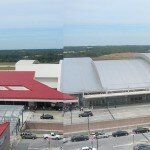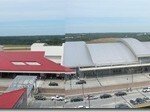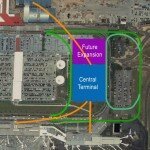Reynolds Tower Likely Dead
In today’s 1:00pm meeting, the Raleigh City Council will review Ted and David Reynolds’ offer to purchase and contract for 301 Hillsborough Street ( agenda: pdf ). The team had planned a mixed-use tower, “ The Hillsborough ” standing around 25 stories, however depreciating real estate has caused a financing shortfall. (The News & Observer’s article today explains this well.)
The council will be deciding whether they should offer the Reynolds an extension, or retract the offer and wait until the real estate markets grow again. It appears that no parties involved are interested in proceeding. Mayor Meeker said, “I’m inclined that we should take the property back and then review the situation when the economy improves.” (way to say it with gusto). David Reynolds said,”…only a fool would get something started right now. There’s just so much uncertainty.”
Likely what will happen is the project will be retracted, the lot will sit fenced in, and the site will the subject of a new Request For Proposals in a couple of years. In the meantime, the possibility that the City of Raleigh will reconsider the site’s future is very real. The city currently has planned to replace its police headquarters with a highrise local governement complex. The long term goal is to replace the current city hall and police headquarters, but the future value of the land on which the current facilities sit is not to be ignored. Land adjacent to one of Raleigh’s two downtown parks would be exceedingly more valuable than land on Hillsborough Street across from…the round Clarion. Keep an eye on this one!
News of The Hillsborough’s demise both gets filed in City Manager Russell Allen’s “See I Told You So” file, and casts much uncertainty on another of the city’s properties, the planned Lafayette hotel, adjacent to the Convention Center Marriott. This story, too, is one worth watching.
Blount Street Commons Slows, Loses Local Management
TBJ is reporting that LNR Property Corp is asking for more time to purchase parts of the Blount street property it had agreed to buy. Also, the state is keeping the lieutenant governor’s office, the Hawkins Hartness House. The economy is being blamed for the changes.
The delays aren’t the only bad sign revealed in the article. It also mentions that Doug Redford, the local guy who made this his pet project from the start, has left LNR. The project is being managed by executives in Charlotte and Atlanta. Uh oh.
North Hills East Revised Plans Submitted
This past week revised plans for North Hills East were submitted to the Raleigh planning department. The site plan (.pdf) merely shows street placements and building footprints, so it is difficult to appreciate the scale of the project without knowing the heights of the buildings. However there seems to be better integration with hidden parking and the supporting streets. There are roughly 20 buildings proposed with very little open space. The plan also uses the existing surrounding street network well.
Reynolds Tower Approved, Gets Financing
The Raleigh City Council voted unanimously Tuesday to allow developers David and Ted Reynolds to move forward with plans to develop the Reynolds Tower, a mixed-use project planned for 301 and 309 Hillsborough Street. Since the last council meeting regarding the project , the developers have secured financing and commitment by Regions Bank.
Hillsborough Street Partners has agreed to purchase the City-owned property at 301 Hillsborough Street. Closing will be done by Dec. 31. Other deadlines set by the City of Raleigh still loom, however. Site and foundation work must begin by February 3, and construction completion must be by March 15, 2011.
City Plaza Construction Begins Today
Work begins today on the much-debated City Plaza on Fayetteville Street . The plaza is expected to be completed by next October.
RDU Shows Off Terminal 2
On Saturday the Raleigh-Durham Airport Authority opened the doors to Phase One of the new Terminal 2 to the public with an impressive open house. The celebration showed off the new 920,000 square foot, $570 million terminal which will offer expanded security areas and improved efficiency with check-in and baggage security and routing.
After being shuttled to the upper levels of the hourly parking garage, visitors were greeted in the parking plaza with a jazz band, the first of many dotted throughout the terminal during this seminal event. Upon entering the front door of the terminal, it is easy to be swept away by the arcing, curved ceiling. Made of glue-laminated layers, the sturdy wood beams carry a shape reminiscent of a wing’s airfoil shape. Dramatic windows have been incorporated to allow in much natural light. The ticketing area contains two island style ticketing stations as well as individual kiosks for express check in.
The layout for the new terminal is essentially the same as that for the old Terminal C; a big “H”. The isthmus, again, is the site of security, only this time, there is no grade change until one is beyond the security areas.
The single, long concourse is similar to that in Terminal C, however the building is about 25 feet wider. The extra room accommodates bidrectional travelators as well as numerous full-service restaurants. The ceiling is a continuation of the arched airfoil concept, and contains many strips of glass to allow in natural light. The three big restaurants that will be open in this phase are 42nd Street Oyster Bar, Carolina Ale House, and Gordon Beirsch.
The concourse features some welcome improvements. The bathrooms are large and well-lit. The seating areas at the gates have some end tables with hidden power outlets. While AC outlets are offered, other form factors such as USB are offered. Finally, the large displays throughout the concourse are on par with the flatscreen displays that are appearing in the nation’s best airports.
As stated before, the isthmus is on the ticketing level, so arriving passengers must ride up a short escalator, then down a long escalator to access the baggage claim areas. The baggage claim area is unremarkable. The best kept secret in this complex, however, is the aluminum tree sculpture at the baggage claim entrance on the lower level. The tree’s base is outside, though some of its branches seemingly “pass through” the building’s two-story windows.
The terminal will no doubt offer an improved ticketing, security, and dining experience. The use of large windows will allow the building to utilize natural light for most of the time that passengers are using the building. Overall, the architectural design is stunning, and will make an excellent impression on those arriving to our area for the first time.
However, upon leaving the building, I have to wonder if this is the best way we could have spent just over half a billion dollars. Will the added natural light’s savings be offset by the additional costs to heat and condition the vast spaces inside the terminal? Will the movement of passengers up and down escalators eventually be seen as a backward way to move people? The facility only offers 4 more gates than Terminal C offered. Will this offer adequate revenues to help pay for this very expensive building? Will people actually use these full-service restaurants on the concourse? I can see this working in a hub setting, but in a point-to-point airport, the only customers they will get is those arriving early for their flight.
The new terminal is much like getting new shoes to wear with suits when your old shoes weren’t that bad…and your casual shoes are embarrassingly awful. The explanation I was given for replacing Terminal C first, instead of Terminal A, is that the airport could not move all of Terminal A’s functions into Terminal C while Terminal A is being replaced. With Terminal 2, they supposedly will be able to move the Terminal A airlines to 2 while replacing A. How will they accomplish this with just four more gates in Terminal 2?
Unfortunately Terminal 2 is another giant missed opportunity in RDU’s history. Ever since 1987 we have operated two airports at RDU; one right across the street from the other. Whether it be parking decks, ticketing areas, baggage claims, runways, control towers, or concourses, there are at least two of everything at RDU. If we’re building a baggage claim facility, a ticketing area, and a security area, why not build such that both concourses can use it?
By building a central terminal and connecting it to just the concourses in the existing terminals, RDU could have set itself up for easy, efficient expansion and renovation in the future as well as incredible efficiency in the present. This design is called the landside/airside design and it has been so beloved in Tampa since 1971 that Orlando used it when it built its new airport in 1981. A central terminal almost the size of Orlando’s could easily fit on the NE side of RDU’s parking decks. People movers are so flexible, that future gates could be put virtually anywhere along the runways.
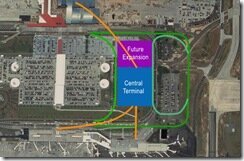 There are two main arguments I’ve heard against the landside/airside design for RDU. One is that Southwest Airlines likes their arrangement in the Terminal B section of Terminal A. They have full control of their gates, their security area, and their baggage claim. They have apparently been resistant to any changes. Second, the inter-runway space between RDU’s two primary runways is much smaller than most airports. The original design was to build twin runways beside Terminal C, so the 5L/23R runway was placed as close as possible to Terminal C to allow for its eventual twin.
There are two main arguments I’ve heard against the landside/airside design for RDU. One is that Southwest Airlines likes their arrangement in the Terminal B section of Terminal A. They have full control of their gates, their security area, and their baggage claim. They have apparently been resistant to any changes. Second, the inter-runway space between RDU’s two primary runways is much smaller than most airports. The original design was to build twin runways beside Terminal C, so the 5L/23R runway was placed as close as possible to Terminal C to allow for its eventual twin.
That said, most airside/landside arrangements have central terminals, but there is no law stating that the central terminal cannot be offset, as depicted above. (The green lines represent roadways and the orange lines represent people movers. Terminals 2 and C can be seen in the top of the picture, while Terminal A is at the bottom.). In fact, if the road entering the airport could be aligned to run along the edge of the parking decks, it would be entirely possible to rebuild Terminal A as a two-sided concourse.
While Terminal 2 is will be impressing a lot of people in the next few years, it depressing to think of what could have been.
UNC School of Dentistry Extracts Cavity-Filled Lab Building
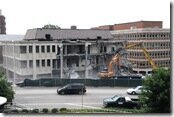 The
UNC School of Dentistry
recently razed it’s 1967 Dental Research Center in preparation for construction of the new Dental Sciences Building. The 200,000 square foot facility will greatly relieve its space deficiencies and enable the school to expand it’s class size by about 33% to 100. A much needed 220-seat auditorium is included in the plan as well as new lecture halls and flexible research space. (Currently the largest auditorium seats 90.)
The
UNC School of Dentistry
recently razed it’s 1967 Dental Research Center in preparation for construction of the new Dental Sciences Building. The 200,000 square foot facility will greatly relieve its space deficiencies and enable the school to expand it’s class size by about 33% to 100. A much needed 220-seat auditorium is included in the plan as well as new lecture halls and flexible research space. (Currently the largest auditorium seats 90.)
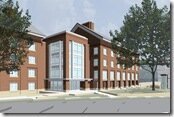 The rendering shown portrays only one wing of the complex. In fact, the rendering in the
school’s official release
(.PDF) more accurately shows building’s role as it brushes the corner of Columbia and Manning.
The rendering shown portrays only one wing of the complex. In fact, the rendering in the
school’s official release
(.PDF) more accurately shows building’s role as it brushes the corner of Columbia and Manning.
The new facility makes a great impression with a more neoclassical veneer than the horrendously depressing modernist Brauer Hall. While the new style creates an amalgam in the complex, much wisdom was used in abandoning the old style.
The new building is aiming for LEED Silver Certification, which includes heat recovery mechanical systems, high performance glazing, rainwater collection, day lighting optimization, and incorporation of materials containing recycled content or renewable resources.
The school anticipates a February groundbreaking and is rooting for the space to be complete in 2011. More can be seen in the school’s official presentation (.PDF)
RBC Set To Dedicate Tower
The official opening of the RBC Plaza begins tomorrow at 1:30pm. Royal Bank of Canada President and CEO Gord Nixon will be on hand, and the bank will announce the five latest grantees of RBC’s Blue Water Project. The Blue Water Project is a grant program designed to support charitable initiatives that foster a culture of water stewardship.
A classy gesture recognizing the recent troubles of the banking industry, RBC is opting to follow the dedication not with base jumpers, but with a simple open house.
Historic Commission Hosts Community Character Lecture
Tonight from 7:30 to 9:00, the Raleigh Historic Districts Commission presents “The Economic Benefits of Community Character”. Speaking will be Donovan Rykema (Place Economics) and Pratt Cassity (University of Georgia Center for Community Design and Preservation).
Our community character (the physical, natural, social and cultural elements of our city and its neighborhoods) and the strength of our economy are what consistently make Raleigh one of the ten best places to live in the country. Don Rypkema and Pratt Cassity, both national experts in urban design, historic preservation and economics, will discuss how our priorities for community design and preservation affect our city’s economic future.
Continue the conversation with your friends and neighbors over coffee and dessert after the lecture.
The event takes place a the Long View Center, 118 S. Person Street, Raleigh .
Oxford Coming to The Hudson
For some reason my first experiment in mobile posting from the International Festival didn’t go through. I’ll work on that one, but nevertheless… a British Pub named The Oxford is coming to the former Yancy’s space on the Fayetteville Street side of The Hudson. It’s being brought to us by the owners of Mura and Sono.
Raleigh’s Nutty Brainstorm
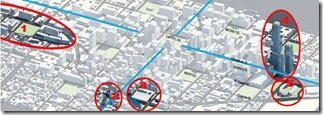 What’s the big idea? On Tuesday the Raleigh planning department released a fantastic
Big Ideas book
(.pdf) which compiles all the dreams put forth by citizens during a few meetings in the spring. July marked the 220th anniversary of the city’s first “planning meeting” which was held at Isacc Hunter’s Tavern. Accordingly, the first of the open anniversary meetings occurred on April 21 at Tir Na Nog. Citizens toasted the future (complete with Cherry Bounce drinks) with a room full of big ideas.
What’s the big idea? On Tuesday the Raleigh planning department released a fantastic
Big Ideas book
(.pdf) which compiles all the dreams put forth by citizens during a few meetings in the spring. July marked the 220th anniversary of the city’s first “planning meeting” which was held at Isacc Hunter’s Tavern. Accordingly, the first of the open anniversary meetings occurred on April 21 at Tir Na Nog. Citizens toasted the future (complete with Cherry Bounce drinks) with a room full of big ideas.
One of the biggest self-help books out there right now is David Allen’s excellent Getting Things Done . The book contains a chapter on brainstorming where Allen advises a simple download of ideas without contamination of value. To Mitchell Silver and the planning department’s credit, that’s exactly what the city got.
From streetcars to riverwalks to giant squirrels, the ideas put forth at several meetings has been compiled into a fun book produced by the city. There are some nutty ideas (that was acorny joke), however the ones earning near future consideration are:
- Redevelop Capital Boulevard as a real boulevard, using Pigeon House Creek for a river walk.
- Build light rail to run through the Glenwood Avenue corridor, connecting downtown with airport, RTP and Durham. Glenwood Avenue outside of Beltline to become a high intensity mixed-use corridor “Glenwood North.”
- Extend the downtown grid southward. Replace freeway aspects of Martin Luther King, Jr. Boulevard with walkable streets. Designate a location for a new arena.
- Create an “emerald necklace” of parks and greenways, including “urban greenways.”
- Redevelop Five Points with mixed uses/entertainment, traffic circle, iconic sculpture in a roundabout.
- Emphasize the natural terrain of the city. Daylight all streams and use these and ridges as a natural conduits of health and creativity.
- Use trolley cars to connect Glenwood South, Five Points, Crabtree, Brier Creek, North Hills and beyond (on Six Forks) and Fayetteville Street.
- Reinvent the edges of downtown. Avenues should connect downtown with neighborhoods.
- Develop a transit/green print/sustainable village across rail tracks from State Fairgrounds.
- Illuminate and define downtown with LED lights.
- Create a manmade lake west of the performing arts complex, ringed with an esplanade or boardwalk and a mix of uses (nightlife, restaurants, retail, and housing).
- Build “Triangle Towers” monument project: group of three tall landmark structures to mark downtown, using light and having an observation deck.
- Make the squirrel the city mascot and scatter squirrel statues (all very eclectic) around the City of Raleigh.
- Reestablish downtown library and grocery store. Arts initiatives: installations and murals. Distinct downtown districts.
- Erect a giant digital screen for outdoor video gaming competitions.
- Build a pedestrian and bike-friendly loop road around Crabtree Valley.
- Install a giant digital screen announcing all cultural events.
- Erect a ferris wheel or world’s first ferris wheel/roller coaster combination.
- Build a doll house village.
- Create a theme park near I-540.
Only one chapter of Big Ideas is closed. The city needs more, however, so feel free to keep the creative juices flowing.
Charter Square Begins Marketing Push
The first iteration of the Charter Square (Warning: music) marketing website is up. More will be added later, but it looks like the seed to a lot of new info to the project. Another interesting site for the project is Craig Davis Properties’ site.
The second part of the push is the new banner wrap around the project’s protective wall. They weren’t able to get it completely in place for Raleigh Wide Open due to the incoming hurricane, but have it up now.
Broughton High School Parking Lot Plan Denied
 Today the Raleigh Planning Commission denied
a plan to expand Broughton High School’s parking needs
(.PDF) by paving the west half of the school’s historic front lawn.
Today the Raleigh Planning Commission denied
a plan to expand Broughton High School’s parking needs
(.PDF) by paving the west half of the school’s historic front lawn.
The grounds at Broughton High School have changed quite a bit over the past few years. The football/soccer/band practice field is now a stadium, and cannot be used for non-athletic events. The school is heavily using, instead, the field across St. Mary’s Street in Fletcher Park. One of the alternative plans to the one denied calls for paving the Fletcher Park field and use it as a parking lot.
Principal Roy Teal spoke to the commission and outlined why he supported a new parking lot on the front lawn. Due to an historic preservation ordinance, trailers are no longer on the front lawn. They are now in the rear parking lot where the teachers used to park. The proposed lot was intended to replace the spaces lost due to the trailer relocation. The school now has 2240 students and 60 parking spaces for them. As a result many more students are parking in surrounding neighborhoods. Mr. Teal feels that students and neighbors would be a lot safer if the students remained on school property as much as possible. He also promised excellent landscaping.
The other change that has seriously impacted the parking situation was the conversion of Cameron Street (“the strip”) to parallel parking. Apparently there was an injury accident a few years ago (and resulting legal action) which prompted the city and the school system to complete the long-prescribed transfer of the strip to the domain of the City. Under City of Raleigh guidelines, 90-degree parking must be at least 18′ deep. The road, however, is only 40′ wide, so there isn’t enough width remaining for traffic to allow 90-degree parking. Several Planning Commission members (including some BHS alumni and parents) requested that the City allow a variance allowing the return of 90-degree parking.
—
One alternative mentioned several times throughout the meeting is a parking deck, most likely on the Fletcher site. The last figure I’ve heard is that these cost around $40,000 per space. If the school needs 400 spaces and has 60 spaces, then a 340-space deck would cost nearly $14 million.
Another alternative is to shrink the school’s enrollment. However because of the magnet program bringing in hundreds of students outside of the school’s “natural” district, many classic Broughton neighborhoods are now districted to other schools such as Sanderson and Athens. Magnet students come with a hefty subsidy from the school system, so if the school were pared down, guess which students would be removed (hint: not the magnet students).
One commission member proposed a variance to move the trailers back to the front lawn.
The plan was denied 6-3 based on the commission’s desire to explore other options for gaining spaces.
What I would like to know is why the school’s stadium wasn’t located in Fletcher Park. It is used a couple of dozen times through the year, and its location in the heart of the BHS campus is requiring hundreds of student trips across a busy St. Mary’s street throughout the year. There is even a natural bowl contour in the seldom-used park, and the existing stadium is so cheap, it could easily be dismantled and relocated to Fletcher Park. The main cost at that point is the grading. Here’s a map of the location to which I’m referring ( http://tinyurl.com/5h2hj5 ).
The best solution is to relocate the stadium and allow variances for the return of the front lawn trailers and the 90-degree parking. If that doesn’t satisfy the parking needs, then pave the field across St. Mary’s Street. It wouldn’t be needed for athletics if the old practice field could be used throughout the year.
Recent Stories
- North Carolina Loses The Great Teacher February 9, 2015
- City Lays Markings for Currituck Obstacle Course February 4, 2015
- History Making Heels and Wolfpack Prepare for Battle January 14, 2015
- 25 Predictions for 2015 January 5, 2015
- Raleigh’s 10 Biggest Stories of 2014 January 2, 2015
- 2014: The Rain Year January 2, 2015
- Tupelo Honey Sets New Casual Standard December 1, 2014
- 2013 Predictions. A Look Back November 18, 2014
- Wicked Taco Bringing Fresh-Mex to Western Blvd November 17, 2014
- DOT Unveils I-440 Widening Plans November 12, 2014
- County Power Shift Brings Major Changes to Raleigh’s Future November 5, 2014
- Jarrett Bay Store Coming to Crabtree September 25, 2014
- FirstWatch Coming to Glenwood Avenue September 9, 2014
- Big Shindig Releases Set Times September 5, 2014
- Appearance Commission to Review Residence Inn September 3, 2014

